
Eutaw House was a notable 19th-century hotel of Baltimore, Maryland, in the United States. [1] Constructed beginning in 1832, officially opened in 1835, Eutaw House was located at the northwest corner of Baltimore and Eutaw Streets. [2]

Eutaw House was a notable 19th-century hotel of Baltimore, Maryland, in the United States. [1] Constructed beginning in 1832, officially opened in 1835, Eutaw House was located at the northwest corner of Baltimore and Eutaw Streets. [2]
Designed by Samuel Harris, it offered 19,000 ft2 of floor space and approximately 230 guest rooms. [3] One of the first guests was William Henry Harrison, and in 1838 "the roof was partly blown off by the same tornado that blew down a section of the wall of the Front Street Theater." [4] Robert Garrett & Sons bought the prestigious hotel in 1845 and upgraded it further, and owned it until it was demolished. [5] [6] In 1859, Robert Coleman, who had run Astor House in New York, took charge of the Eutaw. [6] Abraham Lincoln stayed at the Eutaw House on the way to his inauguration in 1861. [7] Andrew Johnson stopped at the Eutaw on the last leg of his Swing Around the Circle political tour in 1866. [8]
From 1894 it housed the headquarters of the Maryland Democratic Party. [9] The building was gutted by fire in 1912, [10] just before the 1912 Democratic National Convention, [9] and torn down shortly thereafter. The building was replaced with a "theater for motion pictures and vaudeville." [11]

Otakon is an annual three-day anime convention held during July/August. It stands for Otaku Convention. From 1999 to 2016, it took place at the Baltimore Convention Center in Baltimore, Maryland's Inner Harbor district; in 2017, it moved to the Walter E. Washington Convention Center in Washington, D.C. The convention focuses on East Asian popular culture and its fandom. The name is a portmanteau derived from convention and the Japanese word otaku.
Visit Baltimore, formerly the Baltimore Area Convention & Visitors Association (BACVA), is a quasi-public organization started in 1980 by then-Baltimore Mayor William Donald Schaefer. The agency is charged with bringing in tourists and conventions into the city of Baltimore, Maryland, but does not manage the actual convention venues, hotels, or museums in the city.
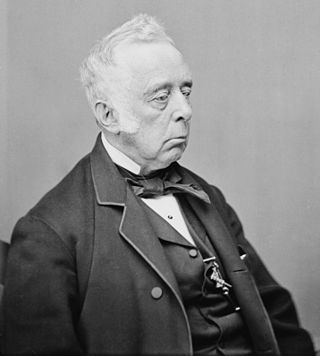
Reverdy Johnson was an American politician, statesman, and jurist from Annapolis, Maryland. He gained fame as a defense attorney, defending notables such as Sandford of the Dred Scott case, Maj. Gen. Fitz John Porter at his courts-martial, and Mary Surratt, alleged conspirator in the assassination of Abraham Lincoln. A former Whig, he was a strong supporter of the Union war effort. At first he opposed wartime efforts to abolish slavery until 1864, and in 1865 supported the 13th Amendment banning slavery.

Thomas Ustick Walter was the dean of American architecture between the 1820 death of Benjamin Latrobe and the emergence of H.H. Richardson in the 1870s. He was the fourth Architect of the Capitol and responsible for adding the north (Senate) and south (House) wings and the central dome that is predominantly the current appearance of the U.S. Capitol building. Walter was one of the founders and second president of the American Institute of Architects. In 1839, he was elected as a member to the American Philosophical Society.
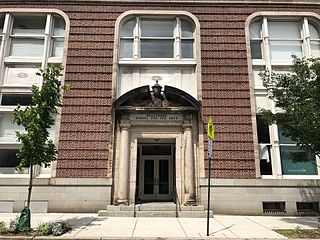
The Baltimore School for the Arts (BSA) is a public performing arts high school located in Mount Vernon, Baltimore, Maryland, United States and is part of the Baltimore City Public Schools system. Established in 1979, The Baltimore School for the Arts offers art concentrations in vocal music, instrumental music, acting, theater production, dance, visual arts and film. The high school has produced numerous "Presidential Scholars" in the Arts and its students have gone on to attend major conservatories and Ivy League Schools.

Green Mount Cemetery is a historic rural cemetery in Baltimore, Maryland, United States. Established on March 15, 1838, and dedicated on July 13, 1839, it is noted for the large number of historical figures interred in its grounds as well as many prominent Baltimore-area families. It retained the name Green Mount when the land was purchased from the heirs of Baltimore merchant Robert Oliver. Green Mount is a treasury of precious works of art, including striking works by major sculptors including William H. Rinehart and Hans Schuler.

Bolton Hill is a neighborhood in Baltimore, Maryland, with 20 blocks of mostly preserved buildings from the late 19th century. It is listed on the National Register of Historic Places, preserved as a Baltimore City Historic District, and included within the boundaries of Baltimore National Heritage Area. The neighborhood is bounded by North Avenue, Mount Royal Avenue, Cathedral Street, Dolphin Street, and Eutaw Place. Bolton Hill is a largely residential neighborhood with three-story row houses with red brick, white marble steps, and high ceilings. There are also larger more ornate originally single-family houses, many houses of worship, parks, monuments, and a few large apartment buildings. Many significant residents have lived in the neighborhood, including F. Scott Fitzgerald, Woodrow Wilson, the Cone sisters, and Florence Rena Sabin.

Power Plant Live! is a collection of bars, restaurants and other businesses in the Inner Harbor section of downtown Baltimore, Maryland. It was developed by The Cordish Companies and opened in phases during 2001, 2002, and 2003. The entertainment complex gets its name from the nearby "Power Plant" building, three blocks south on municipal Pier 4 on East Pratt Street facing the Inner Harbor, which was also later re-developed by Cordish.
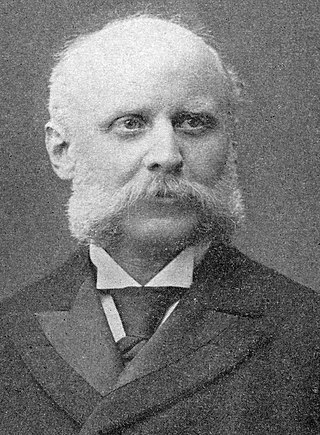
Joshua Levering was a prominent Baptist and a candidate for president of the United States in 1896. He was president of the trustees of The Southern Baptist Theological Seminary in Louisville, Kentucky, president of the Southern Baptist Convention, co-founder of the American Baptist Educational Society, and co-founder of the Layman's Missionary Movement.
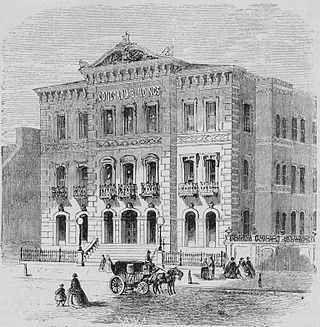
Concordia Hall was a music venue in Baltimore, Maryland. It was founded in 1866 by Germans from the largest immigrant community in that city. It was the location for readings by Charles Dickens in 1868, during his second visit to America., and other visiting lecturers and musical groups, and the site of civic events. Concordia Hall was located on Eutaw Street, south of German Street.

The Episcopal Diocese of Maryland forms part of Province 3 of the Episcopal Church in the United States of America. Having been divided twice, it no longer includes all of Maryland and now consists of the central, northern, and western Maryland counties of Allegany, Anne Arundel, Baltimore, Calvert, Carroll, Frederick, Garrett, Harford, Howard, and Washington, as well as the independent city of Baltimore.

Camden Station, now also referred to as Camden Street Station, Camden Yards, and formally as the Transportation Center at Camden Yards, is a train station at the intersection of South Howard and West Camden Streets in Baltimore, Maryland, adjacent to Oriole Park at Camden Yards, behind the B&O Warehouse. It is served by MARC commuter rail service and local Light Rail trains.
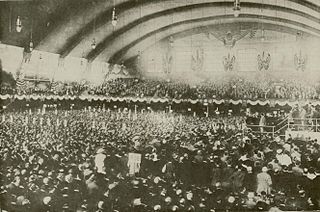
The 1912 Democratic National Convention was held at the Fifth Regiment Armory off North Howard Street in Baltimore from June 25 to July 2, 1912.
Ford's Grand Opera House was a major music venue in Baltimore, Maryland, located on West Fayette Street between North Howard and Eutaw Streets. It was founded by theatre manager John T. Ford and designed by architect James J. Gifford. The opera house/theatre opened to the public on October 2, 1871, with a show that included readings from Shakespeare's "As You Like It" as well as vocal and orchestral performances. Then owned by 1950s–60s era theatre magnate Morris A. Mechanic, it closed almost 93 years later with its last Broadway show from New York City, "Something Funny Happened on the Way to the Forum" in 1964. It was replaced three years later as the prime site for Baltimore live theatre patrons with the opening in the landmark of the new downtown redevelopment project of Charles Center, the starkly modernistic "Brutalist" architecture of the Morris A. Mechanic Theatre at the southwest corner of Charles and Baltimore Streets, four blocks to the east.

The Hippodrome Theatre is a theater in Baltimore, Maryland.
The following is a timeline of the history of the city of Baltimore, Maryland, USA.

John Work Garrett was an American diplomat. His postings included Minister to Venezuela, Argentina, and the Netherlands, and Ambassador to Italy.
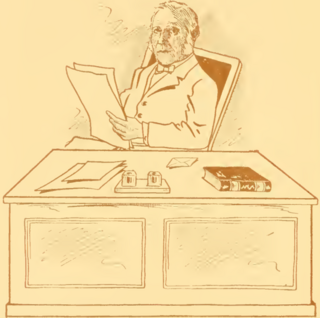
James Henry Jarrett was an American politician and physician from Maryland. He served as a member of the Maryland House of Delegates, representing Harford County in 1856.

Joseph S. Donovan was an American slave trader known for his slave jails in Baltimore, Maryland. Donovan was a major participant in the interregional slave trade, building shipments of enslaved people from the Upper South and delivering them to the Deep South where they would be used, for the most part, on cotton and sugar plantations. As one Baltimore historical researcher and tour guide summarized, "the change from raising tobacco to wheat in the region caused a surplus of labor, whereas the South needed more labor due to the invention of the cotton gin". Donovan, in company with Austin Woolfolk, Bernard M. Campbell, and Hope H. Slatter, have been described as one of the "tycoons of the slave trade" in the Upper South, "responsible for the forced departures of approximately 9000 captives from Baltimore to New Orleans."